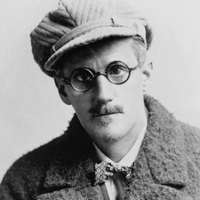Ulysses by James Joyce: Introduction
James Joyce's Ulysses (1922) deals with the events of one day in Dublin in June 1904. The principal characters are Stephen Dedalus (the hero of Joyce's novel 'Portrait of the Artist as a Young Man'), Leopold Bloom, a Jewish advertisement canvasser, and his wife Molly, plot follows the wanderings of Stephen and Bloom through Dublin, and their eventual meeting.

James Joyce
The last chapter is a monologue by Molly Bloom. The various chapters roughly correspond to the episodes of Homer's Odyssey: Stephen representing Telemachus, Bloom as Odysseus, and Molly as Penelope. In the course of the story a public bath, a funeral, a newspaper office, a library, public houses, a maternity hospital and a brothel are visited. The style is highly allusive and employs a variety of techniques, especially those of the stream of consciousness and of parody, and ranges from extreme realism to fantasy.
Buck Mulligan, a medical student, shaves and has breakfast with Stephen Dedalus, teacher. Stephen is worried about his duty to his dead mother. He had refused to pray for her and his hatred of church discipline prevented him from doing so. He also feels that his life has become more aimless through his association with Buck and Haines, a young English-man, who is given to drunken sprees. He is happy when he is out of school and he can walk upon the beach and meditate.
Leopold Bloom, a Jewish advertising salesman, gets out of bed this morning and prepares breakfast for himself and his wife, a sprawling bulk of a woman who is unfaithful to him. He reads a letter from his daughter Milly and thinks of his son Rudy, who died when he was eleven days old. He goes to various stores and to the post office where he picks up a letter from a woman with whom he is having a flirtation. He joins the funeral procession of his old friend Paddy Dignam. He thinks again of his dead son and of his father, who had committed suicide.
Bloom and Stephen meet twice, once in a newspaper office and again in the public library, where Stephen is slightly drunk and expounding his theories about Shakespeare. They do not speak.
During the afternoon and evening Bloom meets various acquaintances and finally runs into Stephen and Mulligan in a pub. Bloom follows Stephen and a medical student as they go to a brothel in the slums of Dublin. Bloom is thinking of his wife's infidelity. Stephen, very drunk now, thinks again of his dead mother. He is engaged in a scuffle with two British soldiers when Bloom rescues him and takes him home.
As Bloom fumbles for his key, he begs Stephen to leave the drunken medical student and come to live with him. Stephen refuses and goes off alone down the street as Bloom enters his house. He stands looking down at his slovenly wife who is lying in bed thinking of her lovers and of her romantic meeting and honeymoon with Bloom in Spain. Her thoughts continue to flow on as Bloom begins to snore by her side.
The stream of consciousness technique finds its best exposition in Joyce’s masterpiece, Ulysses. The novel is set in Dublin and seeks to represent and reconstruct Dublin life in all its sordid realism. It narrates in a rambling manner i.e. the wanderings of Leopold Bloom and Stephen Dedalus through the city Dublin, on one particular day. The novel is extremely formless, loose and incoherent. It is the reduction absurdum of the extreme subjective method. The style in the novel is marked with rare ingenuity, witticism and satirical flashes. The novel has been called a “comic-epic” in which the novelist went deeper and further than any other novelist in the handling of the interior monologue and the stream of consciousness technique. Ulysses may be little read today but Joyce’s greatness as an artist cannot be questioned.
